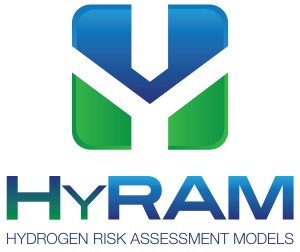
With recent hydrogen fuel cell vehicle market acceleration, cities and neighborhoods where these cars are being sold exhibit a growing need to advance hydrogen fueling system deployments. Understanding and assessing hydrogen-fueling and -storage system risks is a challenging proposition because the necessary scientific information is diffuse and found only in isolated published papers, within research organizations, or encumbered as proprietary information. Sandia National Laboratories is working to change that with its Hydrogen Risk Assessment Model (HyRAM), a first-ever toolkit that integrates the risk-assessment process with the hydrogen-specific scientific information to enable users interested in hydrogen facility development.
Sandia will demonstrate a HyRAM toolkit prototype at the Department of Energy’s Annual Merit Review in Washington, DC on June 19 from 4:30-6 pm at the Washington Marriott Wardman Park Hotel, Balcony B. Developed under DOE’s Hydrogen Safety Codes and Standards program, HyRAM integrates recently developed physical, engineering, and probabilistic models for hydrogen fueling and storage infrastructure into a software toolkit that can be used to assess hazards and risks.
“We are very excited to demonstrate the HyRAM prototype,” said Sandia risk analyst Katrina Groth. “This toolkit will enable hydrogen facility developers to access information necessary to deploy new hydrogen fueling systems. This toolkit puts the latest research findings, computational models, and expertise of the international hydrogen safety research community into the hands of decision-makers.”
The HyRAM toolkit is the first-ever software toolkit that integrates deterministic and probabilistic models for quantifying accident scenarios, predicting physical effects, and characterizing hydrogen hazards’ impact on people and structures. HyRAM incorporates generic probabilities for equipment failures and probabilistic models for heat-flux impact on humans and structures, with computationally and experimentally validated models of hydrogen release and flame physics.
The initial modules can be used to quantify the likelihood and thermal consequences associated with gaseous hydrogen releases from user-defined hydrogen installations. Future development activities will integrate additional consequence models and develop user interfaces for additional audiences. When completed, the toolkit will enable industry-, SDOs (standards development organizations)-, and CDO (code development organizations)-led quantitative risk assessment and performance-based engineering with state-of-the-art, validated science and engineering models.
This prototype demonstration is an opportunity for interested users to provide feedback on the initial user interfaces and modules. During this meeting, Sandia will demonstrate existing and planned HyRAM modules and discuss user needs and priorities. For more information, contact Katrina Groth at kgroth@sandia.gov.